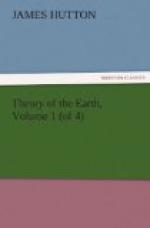M. le Comte de Buffon has attempted to explain the crystallization of bodies, or production of mineral forms, by the accretion or juxtaposition of elementary bodies, which have only form in two dimensions, length and breadth; that is to say, that mineral concretions are composed of surfaces alone, and not of bodies. This however is only an attempt to explain, what we do not understand, by a proposition which is either evidently contradictory, or plainly inconceivable. It is true that this eloquent and ingenious author endeavours to correct the palpable absurdity of the proposition, by representing the constituent parts of the mineral bodies as “de lames infiniment minces;” but who is it does not see, that these infinitely thin plates are no other than bodies of three dimensions, contrary to the supposition; for, infinitely thin, means a certain thickness; but the smallest possible or assignable thickness differs as much from a perfect superficies as the greatest.
M. de Luc has given us his ideas of petrifaction with sufficient precision of term and clearness of expression; his opinion, therefore, deserves to be examined; and, as his theory of petrifaction is equally applicable to every species of substance, it is necessary again to examine this subject, notwithstanding of what has been already said, in the first part of this work, concerning consolidation and mineral concretion from the fluid state of fusion.
This author has perhaps properly exposed Woodward’s Theory of Petrification in saying[33], “Son erreur a cet egard vient de ce qu’il n’a point reflechi sur la maniere dont se fait la petrifaction. Il ramollit d’abord les pierres pour y faire entrer les coquilles, sans bien connoitre l’agent qu’il y employe; et il les duroit ensuite, sans reflechir au comment.” To avoid this error or defect, M. de Luc, in his Theory of Petrifaction, sets out with the acknowledged principle of cohesion; and, in order to consolidate strata of a porous texture, he supposes water carrying minute bodies of all shapes and sizes, and depositing them in such close contact as to produce solidity and concretion. Now, if Dr Woodward softened stones without a proper cause, M. de Luc, in employing the specious principle of cohesion, has consolidated them upon no better grounds; for, the application of this principle is as foreign to his purpose, as is that of magnetism. Bodies, it is true, cohere when their surfaces are closely applied to each other; But how apply this principle to consolidation?—only by supposing all the separate bodies, of which the solid is to be composed, to be in perfect contact in all their surfaces. But this, in other words, is supposing the body to be solid; and, to suppose the agent, water, capable of thus making hard bodies solid, is no other than having recourse to the fortuitous concourse of atoms to make a world; a thought which this author would surely hold in great contempt.
[Note 33: Lettres Physiques et Morales.]




